Comparison of Insider Trading in Australia and Hong Kong
VerifiedAdded on 2019/10/31
|7
|1378
|233
Report
AI Summary
The assignment content compares the insider trading laws in Australia and Hong Kong. Both jurisdictions have civil and criminal provisions for insider trading, with a focus on material confidential information that has not been made public. The Australian regime is governed by the Corporations Act, while Hong Kong's laws are covered under the Securities and Futures Ordinance. The article highlights key similarities and differences between the two regimes, including the requirement of connection in Hong Kong, which does not exist in Australia. It also discusses the importance of market integrity theory and fraud theory in both jurisdictions.
Contribute Materials
Your contribution can guide someone’s learning journey. Share your
documents today.
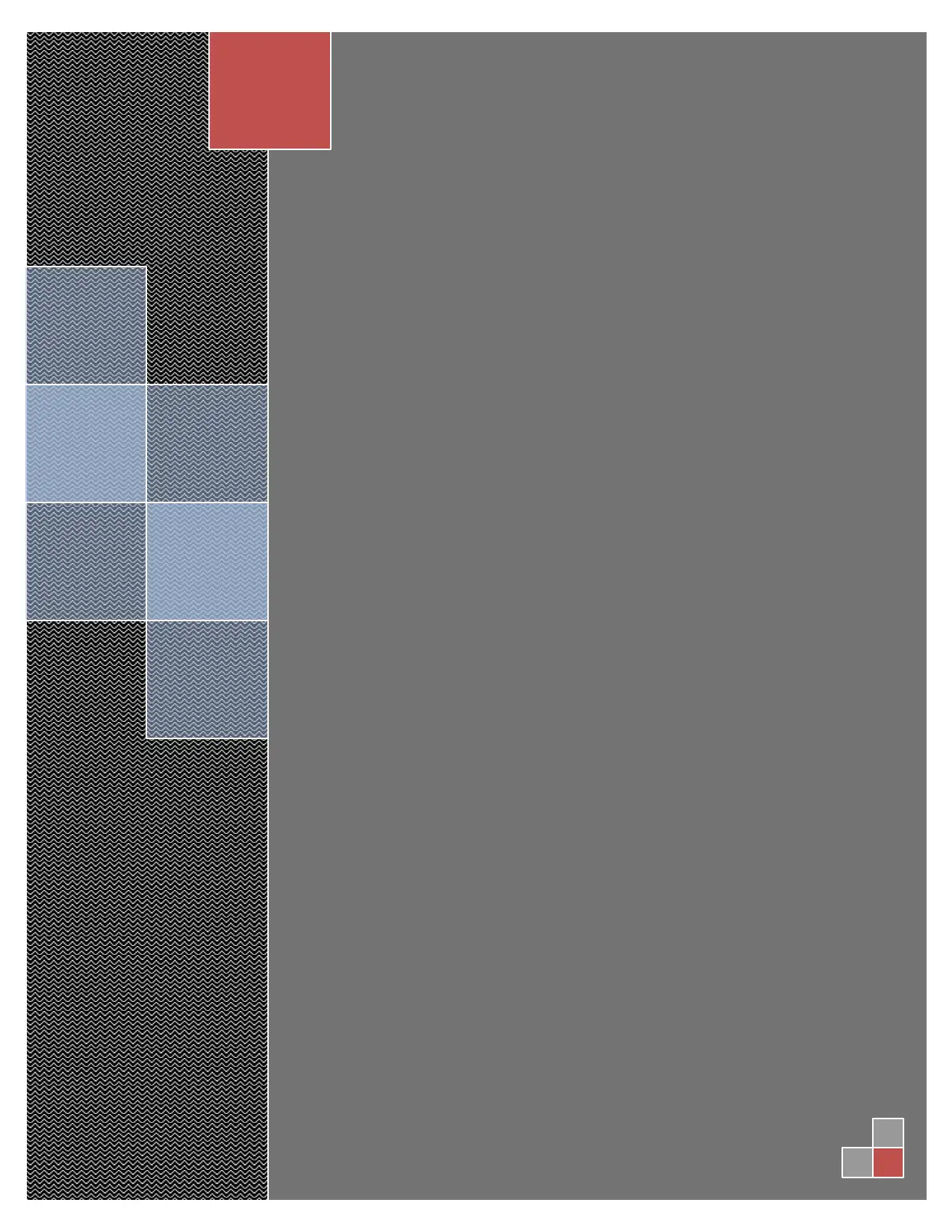
Secure Best Marks with AI Grader
Need help grading? Try our AI Grader for instant feedback on your assignments.
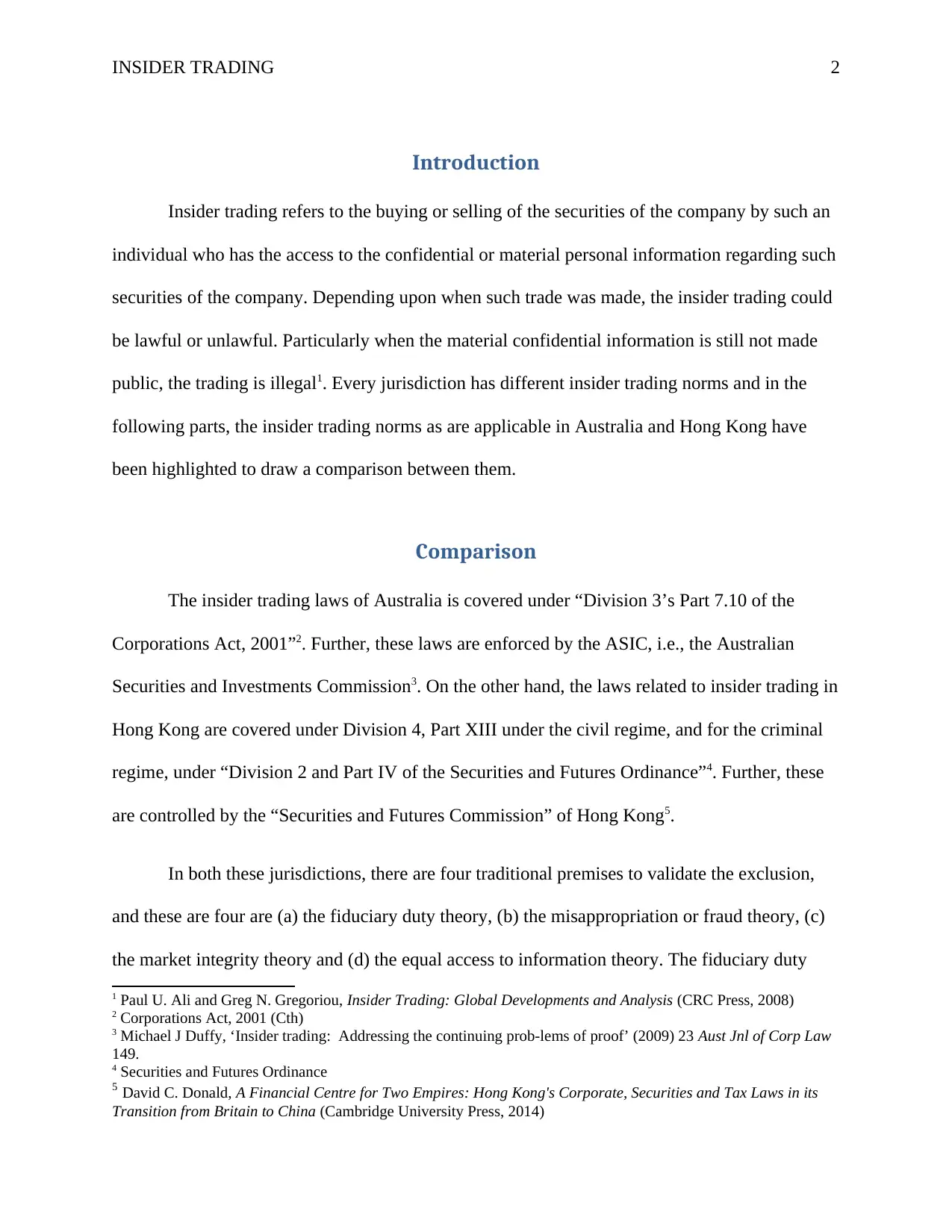
INSIDER TRADING 2
Introduction
Insider trading refers to the buying or selling of the securities of the company by such an
individual who has the access to the confidential or material personal information regarding such
securities of the company. Depending upon when such trade was made, the insider trading could
be lawful or unlawful. Particularly when the material confidential information is still not made
public, the trading is illegal1. Every jurisdiction has different insider trading norms and in the
following parts, the insider trading norms as are applicable in Australia and Hong Kong have
been highlighted to draw a comparison between them.
Comparison
The insider trading laws of Australia is covered under “Division 3’s Part 7.10 of the
Corporations Act, 2001”2. Further, these laws are enforced by the ASIC, i.e., the Australian
Securities and Investments Commission3. On the other hand, the laws related to insider trading in
Hong Kong are covered under Division 4, Part XIII under the civil regime, and for the criminal
regime, under “Division 2 and Part IV of the Securities and Futures Ordinance”4. Further, these
are controlled by the “Securities and Futures Commission” of Hong Kong5.
In both these jurisdictions, there are four traditional premises to validate the exclusion,
and these are four are (a) the fiduciary duty theory, (b) the misappropriation or fraud theory, (c)
the market integrity theory and (d) the equal access to information theory. The fiduciary duty
1 Paul U. Ali and Greg N. Gregoriou, Insider Trading: Global Developments and Analysis (CRC Press, 2008)
2 Corporations Act, 2001 (Cth)
3 Michael J Duffy, ‘Insider trading: Addressing the continuing prob-lems of proof’ (2009) 23 Aust Jnl of Corp Law
149.
4 Securities and Futures Ordinance
5 David C. Donald, A Financial Centre for Two Empires: Hong Kong's Corporate, Securities and Tax Laws in its
Transition from Britain to China (Cambridge University Press, 2014)
Introduction
Insider trading refers to the buying or selling of the securities of the company by such an
individual who has the access to the confidential or material personal information regarding such
securities of the company. Depending upon when such trade was made, the insider trading could
be lawful or unlawful. Particularly when the material confidential information is still not made
public, the trading is illegal1. Every jurisdiction has different insider trading norms and in the
following parts, the insider trading norms as are applicable in Australia and Hong Kong have
been highlighted to draw a comparison between them.
Comparison
The insider trading laws of Australia is covered under “Division 3’s Part 7.10 of the
Corporations Act, 2001”2. Further, these laws are enforced by the ASIC, i.e., the Australian
Securities and Investments Commission3. On the other hand, the laws related to insider trading in
Hong Kong are covered under Division 4, Part XIII under the civil regime, and for the criminal
regime, under “Division 2 and Part IV of the Securities and Futures Ordinance”4. Further, these
are controlled by the “Securities and Futures Commission” of Hong Kong5.
In both these jurisdictions, there are four traditional premises to validate the exclusion,
and these are four are (a) the fiduciary duty theory, (b) the misappropriation or fraud theory, (c)
the market integrity theory and (d) the equal access to information theory. The fiduciary duty
1 Paul U. Ali and Greg N. Gregoriou, Insider Trading: Global Developments and Analysis (CRC Press, 2008)
2 Corporations Act, 2001 (Cth)
3 Michael J Duffy, ‘Insider trading: Addressing the continuing prob-lems of proof’ (2009) 23 Aust Jnl of Corp Law
149.
4 Securities and Futures Ordinance
5 David C. Donald, A Financial Centre for Two Empires: Hong Kong's Corporate, Securities and Tax Laws in its
Transition from Britain to China (Cambridge University Press, 2014)
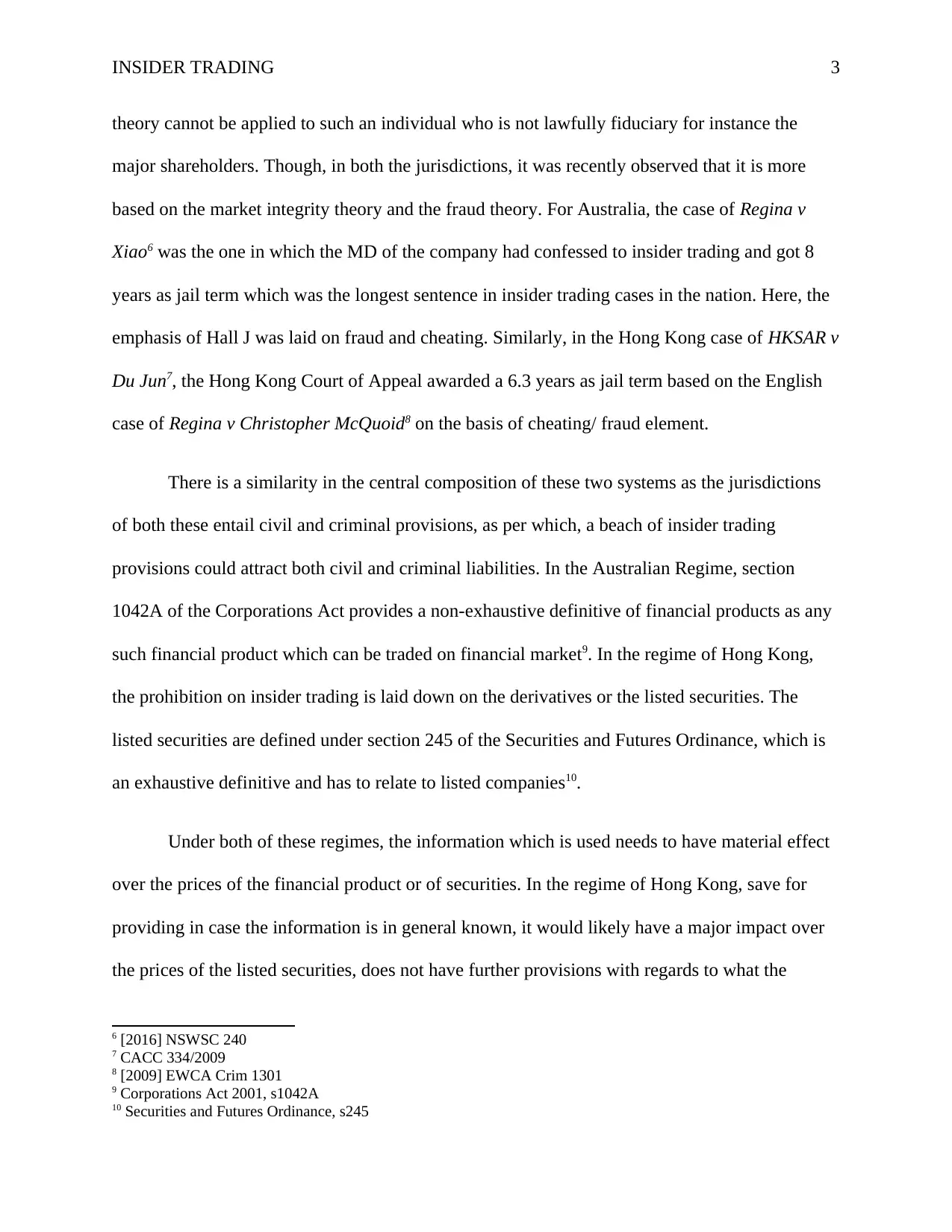
INSIDER TRADING 3
theory cannot be applied to such an individual who is not lawfully fiduciary for instance the
major shareholders. Though, in both the jurisdictions, it was recently observed that it is more
based on the market integrity theory and the fraud theory. For Australia, the case of Regina v
Xiao6 was the one in which the MD of the company had confessed to insider trading and got 8
years as jail term which was the longest sentence in insider trading cases in the nation. Here, the
emphasis of Hall J was laid on fraud and cheating. Similarly, in the Hong Kong case of HKSAR v
Du Jun7, the Hong Kong Court of Appeal awarded a 6.3 years as jail term based on the English
case of Regina v Christopher McQuoid8 on the basis of cheating/ fraud element.
There is a similarity in the central composition of these two systems as the jurisdictions
of both these entail civil and criminal provisions, as per which, a beach of insider trading
provisions could attract both civil and criminal liabilities. In the Australian Regime, section
1042A of the Corporations Act provides a non-exhaustive definitive of financial products as any
such financial product which can be traded on financial market9. In the regime of Hong Kong,
the prohibition on insider trading is laid down on the derivatives or the listed securities. The
listed securities are defined under section 245 of the Securities and Futures Ordinance, which is
an exhaustive definitive and has to relate to listed companies10.
Under both of these regimes, the information which is used needs to have material effect
over the prices of the financial product or of securities. In the regime of Hong Kong, save for
providing in case the information is in general known, it would likely have a major impact over
the prices of the listed securities, does not have further provisions with regards to what the
6 [2016] NSWSC 240
7 CACC 334/2009
8 [2009] EWCA Crim 1301
9 Corporations Act 2001, s1042A
10 Securities and Futures Ordinance, s245
theory cannot be applied to such an individual who is not lawfully fiduciary for instance the
major shareholders. Though, in both the jurisdictions, it was recently observed that it is more
based on the market integrity theory and the fraud theory. For Australia, the case of Regina v
Xiao6 was the one in which the MD of the company had confessed to insider trading and got 8
years as jail term which was the longest sentence in insider trading cases in the nation. Here, the
emphasis of Hall J was laid on fraud and cheating. Similarly, in the Hong Kong case of HKSAR v
Du Jun7, the Hong Kong Court of Appeal awarded a 6.3 years as jail term based on the English
case of Regina v Christopher McQuoid8 on the basis of cheating/ fraud element.
There is a similarity in the central composition of these two systems as the jurisdictions
of both these entail civil and criminal provisions, as per which, a beach of insider trading
provisions could attract both civil and criminal liabilities. In the Australian Regime, section
1042A of the Corporations Act provides a non-exhaustive definitive of financial products as any
such financial product which can be traded on financial market9. In the regime of Hong Kong,
the prohibition on insider trading is laid down on the derivatives or the listed securities. The
listed securities are defined under section 245 of the Securities and Futures Ordinance, which is
an exhaustive definitive and has to relate to listed companies10.
Under both of these regimes, the information which is used needs to have material effect
over the prices of the financial product or of securities. In the regime of Hong Kong, save for
providing in case the information is in general known, it would likely have a major impact over
the prices of the listed securities, does not have further provisions with regards to what the
6 [2016] NSWSC 240
7 CACC 334/2009
8 [2009] EWCA Crim 1301
9 Corporations Act 2001, s1042A
10 Securities and Futures Ordinance, s245
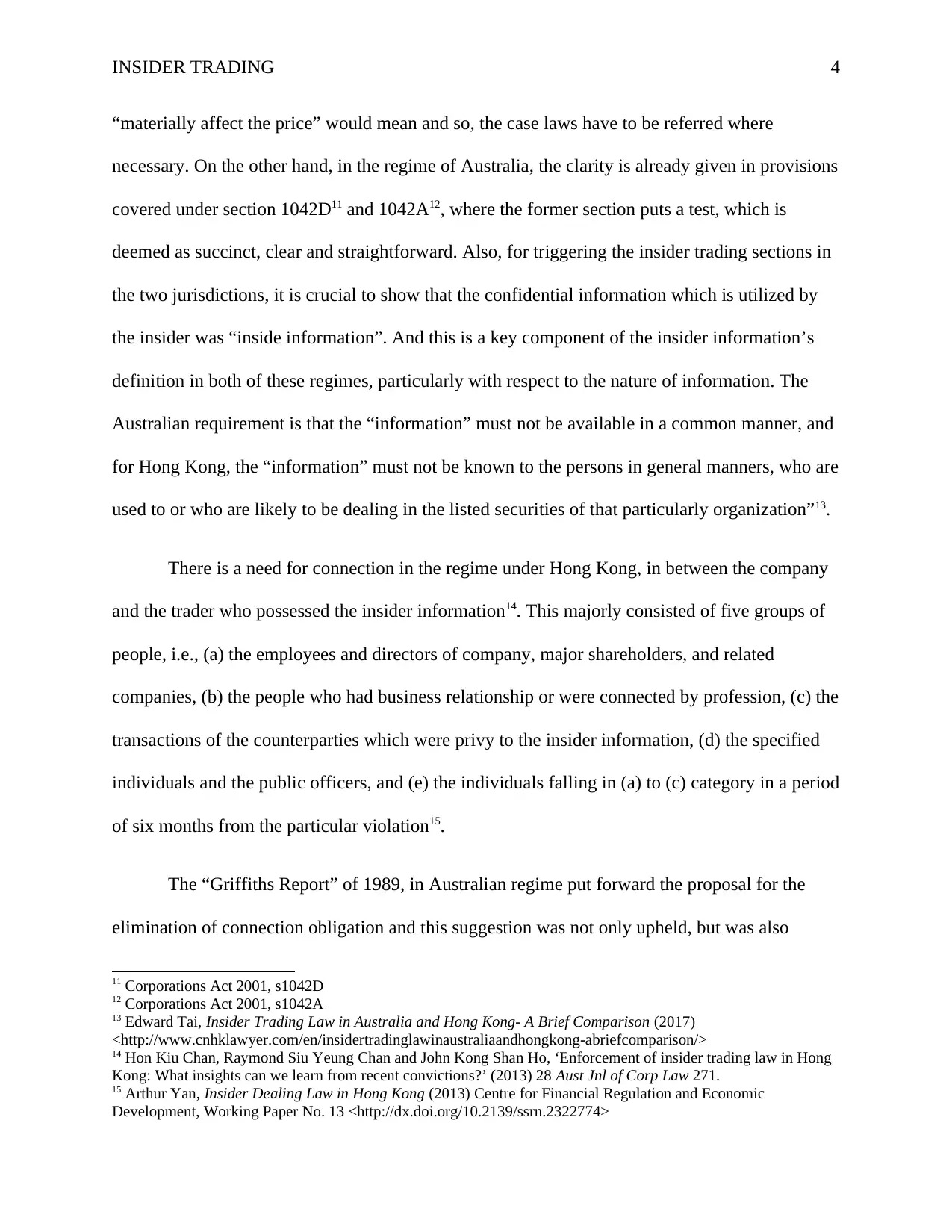
INSIDER TRADING 4
“materially affect the price” would mean and so, the case laws have to be referred where
necessary. On the other hand, in the regime of Australia, the clarity is already given in provisions
covered under section 1042D11 and 1042A12, where the former section puts a test, which is
deemed as succinct, clear and straightforward. Also, for triggering the insider trading sections in
the two jurisdictions, it is crucial to show that the confidential information which is utilized by
the insider was “inside information”. And this is a key component of the insider information’s
definition in both of these regimes, particularly with respect to the nature of information. The
Australian requirement is that the “information” must not be available in a common manner, and
for Hong Kong, the “information” must not be known to the persons in general manners, who are
used to or who are likely to be dealing in the listed securities of that particularly organization”13.
There is a need for connection in the regime under Hong Kong, in between the company
and the trader who possessed the insider information14. This majorly consisted of five groups of
people, i.e., (a) the employees and directors of company, major shareholders, and related
companies, (b) the people who had business relationship or were connected by profession, (c) the
transactions of the counterparties which were privy to the insider information, (d) the specified
individuals and the public officers, and (e) the individuals falling in (a) to (c) category in a period
of six months from the particular violation15.
The “Griffiths Report” of 1989, in Australian regime put forward the proposal for the
elimination of connection obligation and this suggestion was not only upheld, but was also
11 Corporations Act 2001, s1042D
12 Corporations Act 2001, s1042A
13 Edward Tai, Insider Trading Law in Australia and Hong Kong- A Brief Comparison (2017)
<http://www.cnhklawyer.com/en/insidertradinglawinaustraliaandhongkong-abriefcomparison/>
14 Hon Kiu Chan, Raymond Siu Yeung Chan and John Kong Shan Ho, ‘Enforcement of insider trading law in Hong
Kong: What insights can we learn from recent convictions?’ (2013) 28 Aust Jnl of Corp Law 271.
15 Arthur Yan, Insider Dealing Law in Hong Kong (2013) Centre for Financial Regulation and Economic
Development, Working Paper No. 13 <http://dx.doi.org/10.2139/ssrn.2322774>
“materially affect the price” would mean and so, the case laws have to be referred where
necessary. On the other hand, in the regime of Australia, the clarity is already given in provisions
covered under section 1042D11 and 1042A12, where the former section puts a test, which is
deemed as succinct, clear and straightforward. Also, for triggering the insider trading sections in
the two jurisdictions, it is crucial to show that the confidential information which is utilized by
the insider was “inside information”. And this is a key component of the insider information’s
definition in both of these regimes, particularly with respect to the nature of information. The
Australian requirement is that the “information” must not be available in a common manner, and
for Hong Kong, the “information” must not be known to the persons in general manners, who are
used to or who are likely to be dealing in the listed securities of that particularly organization”13.
There is a need for connection in the regime under Hong Kong, in between the company
and the trader who possessed the insider information14. This majorly consisted of five groups of
people, i.e., (a) the employees and directors of company, major shareholders, and related
companies, (b) the people who had business relationship or were connected by profession, (c) the
transactions of the counterparties which were privy to the insider information, (d) the specified
individuals and the public officers, and (e) the individuals falling in (a) to (c) category in a period
of six months from the particular violation15.
The “Griffiths Report” of 1989, in Australian regime put forward the proposal for the
elimination of connection obligation and this suggestion was not only upheld, but was also
11 Corporations Act 2001, s1042D
12 Corporations Act 2001, s1042A
13 Edward Tai, Insider Trading Law in Australia and Hong Kong- A Brief Comparison (2017)
<http://www.cnhklawyer.com/en/insidertradinglawinaustraliaandhongkong-abriefcomparison/>
14 Hon Kiu Chan, Raymond Siu Yeung Chan and John Kong Shan Ho, ‘Enforcement of insider trading law in Hong
Kong: What insights can we learn from recent convictions?’ (2013) 28 Aust Jnl of Corp Law 271.
15 Arthur Yan, Insider Dealing Law in Hong Kong (2013) Centre for Financial Regulation and Economic
Development, Working Paper No. 13 <http://dx.doi.org/10.2139/ssrn.2322774>
Secure Best Marks with AI Grader
Need help grading? Try our AI Grader for instant feedback on your assignments.
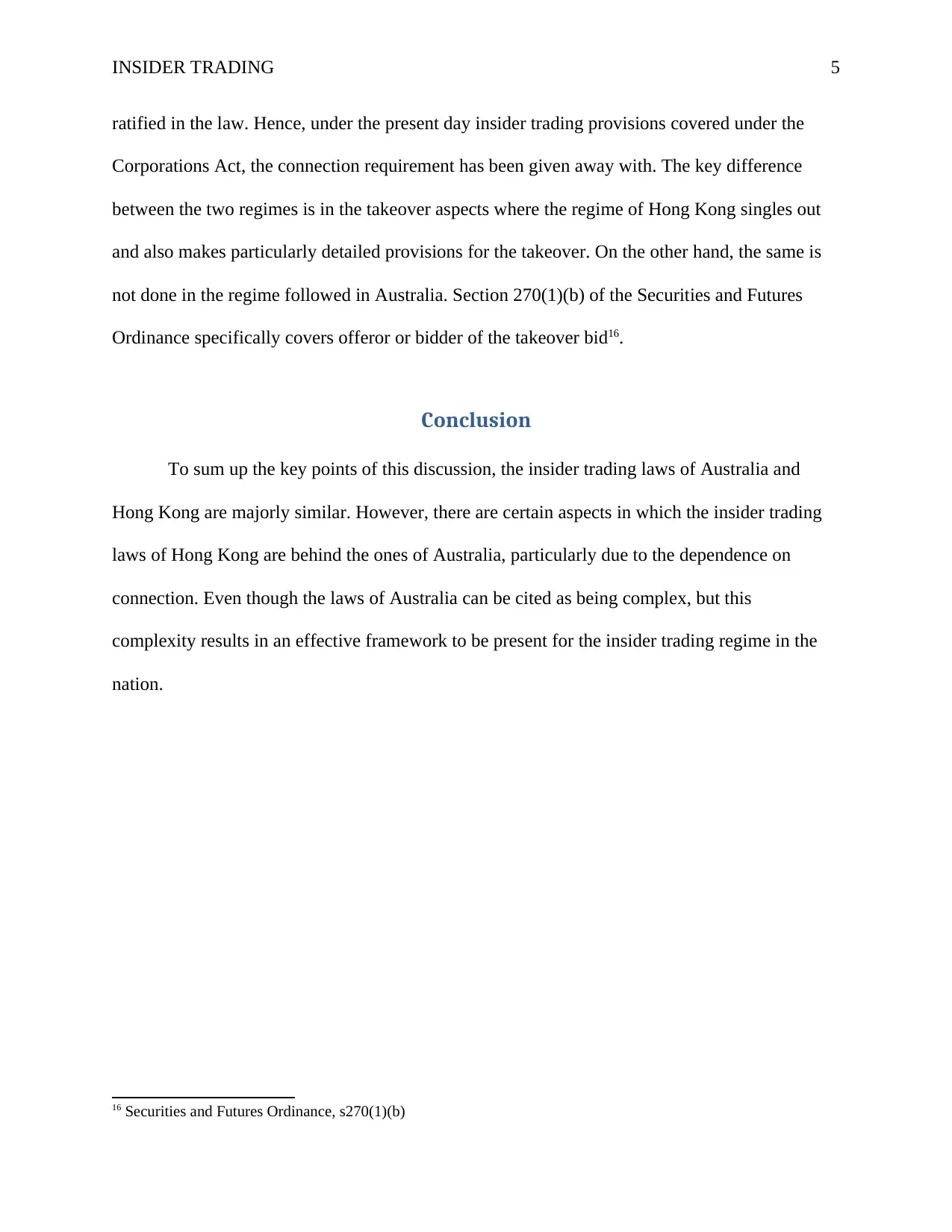
INSIDER TRADING 5
ratified in the law. Hence, under the present day insider trading provisions covered under the
Corporations Act, the connection requirement has been given away with. The key difference
between the two regimes is in the takeover aspects where the regime of Hong Kong singles out
and also makes particularly detailed provisions for the takeover. On the other hand, the same is
not done in the regime followed in Australia. Section 270(1)(b) of the Securities and Futures
Ordinance specifically covers offeror or bidder of the takeover bid16.
Conclusion
To sum up the key points of this discussion, the insider trading laws of Australia and
Hong Kong are majorly similar. However, there are certain aspects in which the insider trading
laws of Hong Kong are behind the ones of Australia, particularly due to the dependence on
connection. Even though the laws of Australia can be cited as being complex, but this
complexity results in an effective framework to be present for the insider trading regime in the
nation.
16 Securities and Futures Ordinance, s270(1)(b)
ratified in the law. Hence, under the present day insider trading provisions covered under the
Corporations Act, the connection requirement has been given away with. The key difference
between the two regimes is in the takeover aspects where the regime of Hong Kong singles out
and also makes particularly detailed provisions for the takeover. On the other hand, the same is
not done in the regime followed in Australia. Section 270(1)(b) of the Securities and Futures
Ordinance specifically covers offeror or bidder of the takeover bid16.
Conclusion
To sum up the key points of this discussion, the insider trading laws of Australia and
Hong Kong are majorly similar. However, there are certain aspects in which the insider trading
laws of Hong Kong are behind the ones of Australia, particularly due to the dependence on
connection. Even though the laws of Australia can be cited as being complex, but this
complexity results in an effective framework to be present for the insider trading regime in the
nation.
16 Securities and Futures Ordinance, s270(1)(b)
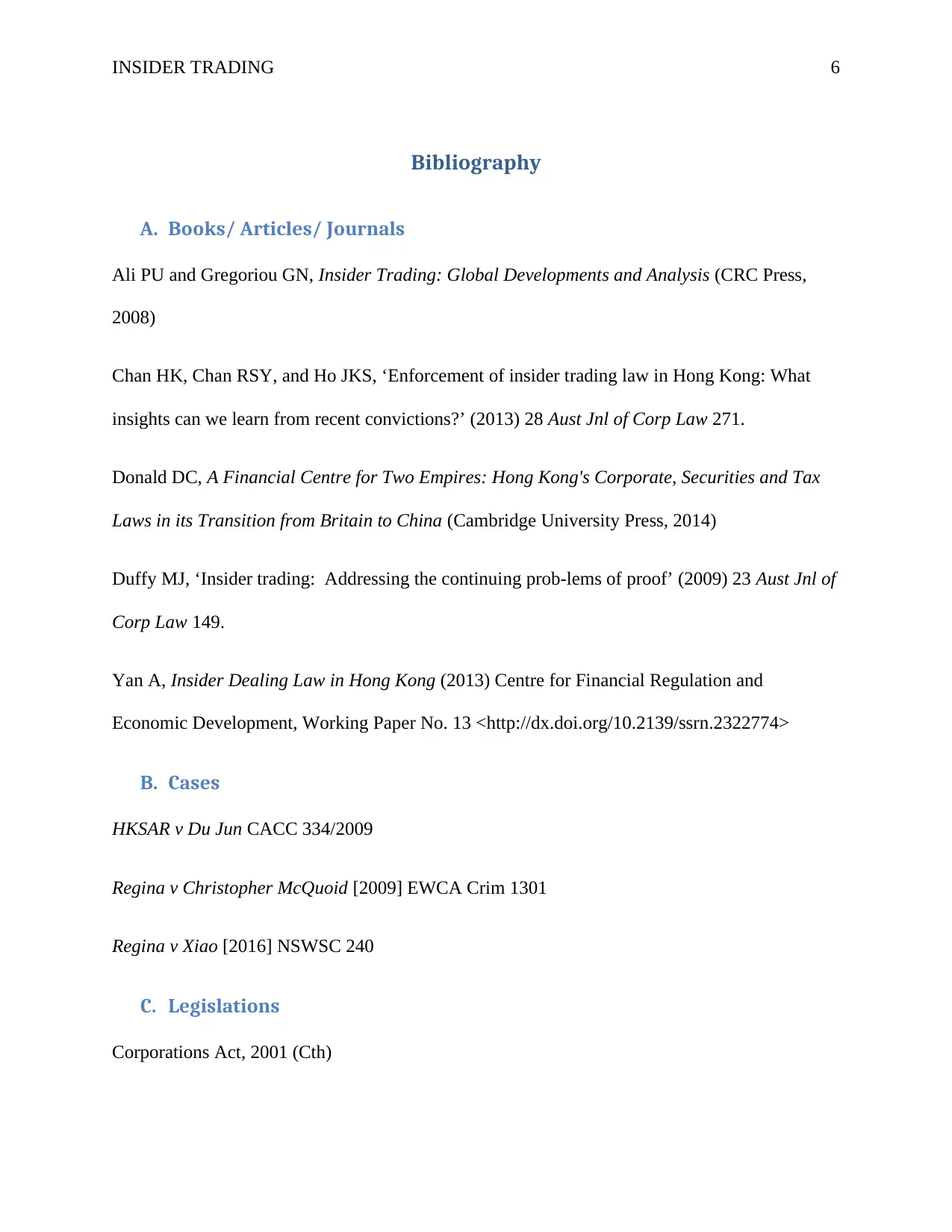
INSIDER TRADING 6
Bibliography
A. Books/ Articles/ Journals
Ali PU and Gregoriou GN, Insider Trading: Global Developments and Analysis (CRC Press,
2008)
Chan HK, Chan RSY, and Ho JKS, ‘Enforcement of insider trading law in Hong Kong: What
insights can we learn from recent convictions?’ (2013) 28 Aust Jnl of Corp Law 271.
Donald DC, A Financial Centre for Two Empires: Hong Kong's Corporate, Securities and Tax
Laws in its Transition from Britain to China (Cambridge University Press, 2014)
Duffy MJ, ‘Insider trading: Addressing the continuing prob-lems of proof’ (2009) 23 Aust Jnl of
Corp Law 149.
Yan A, Insider Dealing Law in Hong Kong (2013) Centre for Financial Regulation and
Economic Development, Working Paper No. 13 <http://dx.doi.org/10.2139/ssrn.2322774>
B. Cases
HKSAR v Du Jun CACC 334/2009
Regina v Christopher McQuoid [2009] EWCA Crim 1301
Regina v Xiao [2016] NSWSC 240
C. Legislations
Corporations Act, 2001 (Cth)
Bibliography
A. Books/ Articles/ Journals
Ali PU and Gregoriou GN, Insider Trading: Global Developments and Analysis (CRC Press,
2008)
Chan HK, Chan RSY, and Ho JKS, ‘Enforcement of insider trading law in Hong Kong: What
insights can we learn from recent convictions?’ (2013) 28 Aust Jnl of Corp Law 271.
Donald DC, A Financial Centre for Two Empires: Hong Kong's Corporate, Securities and Tax
Laws in its Transition from Britain to China (Cambridge University Press, 2014)
Duffy MJ, ‘Insider trading: Addressing the continuing prob-lems of proof’ (2009) 23 Aust Jnl of
Corp Law 149.
Yan A, Insider Dealing Law in Hong Kong (2013) Centre for Financial Regulation and
Economic Development, Working Paper No. 13 <http://dx.doi.org/10.2139/ssrn.2322774>
B. Cases
HKSAR v Du Jun CACC 334/2009
Regina v Christopher McQuoid [2009] EWCA Crim 1301
Regina v Xiao [2016] NSWSC 240
C. Legislations
Corporations Act, 2001 (Cth)
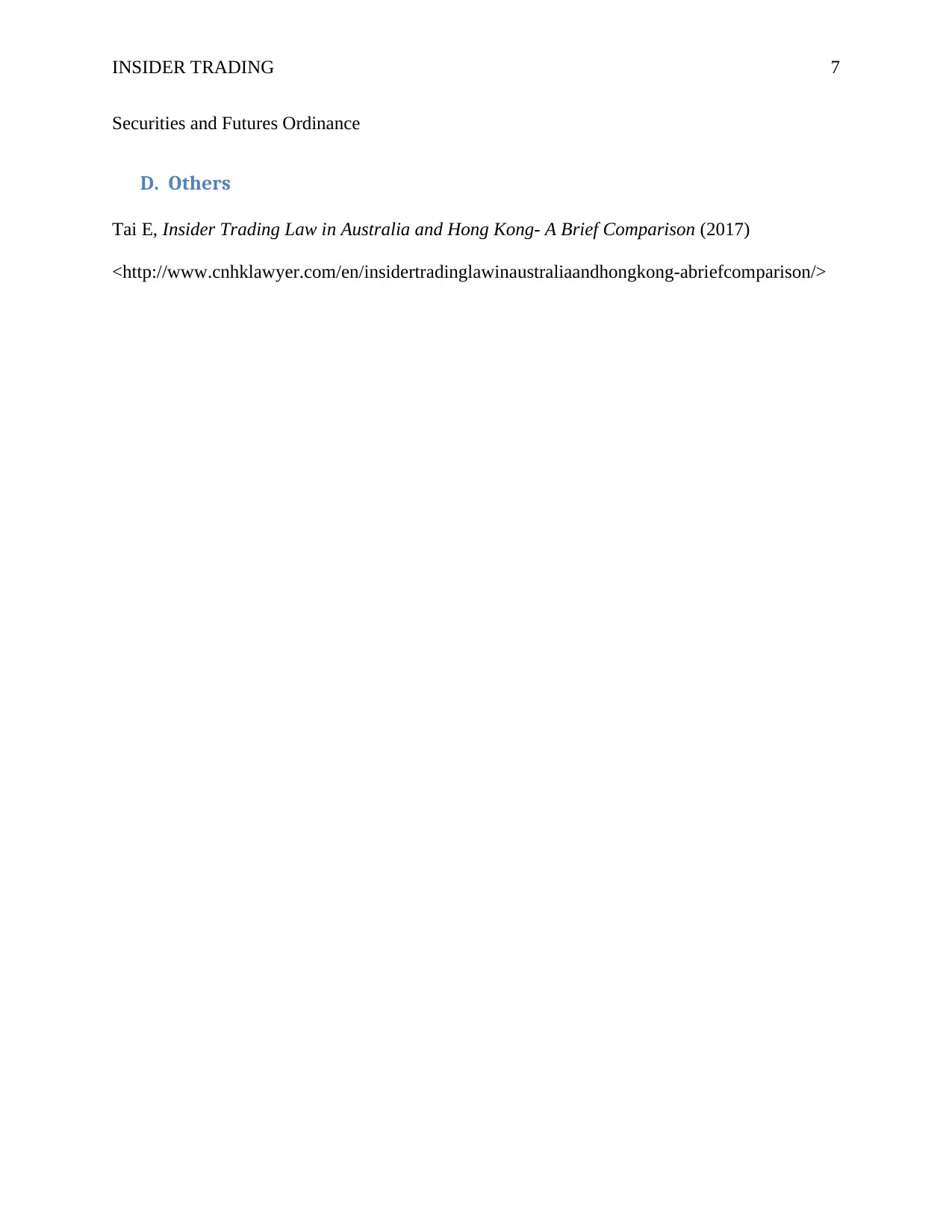
INSIDER TRADING 7
Securities and Futures Ordinance
D. Others
Tai E, Insider Trading Law in Australia and Hong Kong- A Brief Comparison (2017)
<http://www.cnhklawyer.com/en/insidertradinglawinaustraliaandhongkong-abriefcomparison/>
Securities and Futures Ordinance
D. Others
Tai E, Insider Trading Law in Australia and Hong Kong- A Brief Comparison (2017)
<http://www.cnhklawyer.com/en/insidertradinglawinaustraliaandhongkong-abriefcomparison/>
1 out of 7
Your All-in-One AI-Powered Toolkit for Academic Success.
+13062052269
info@desklib.com
Available 24*7 on WhatsApp / Email
![[object Object]](/_next/static/media/star-bottom.7253800d.svg)
Unlock your academic potential
© 2024 | Zucol Services PVT LTD | All rights reserved.